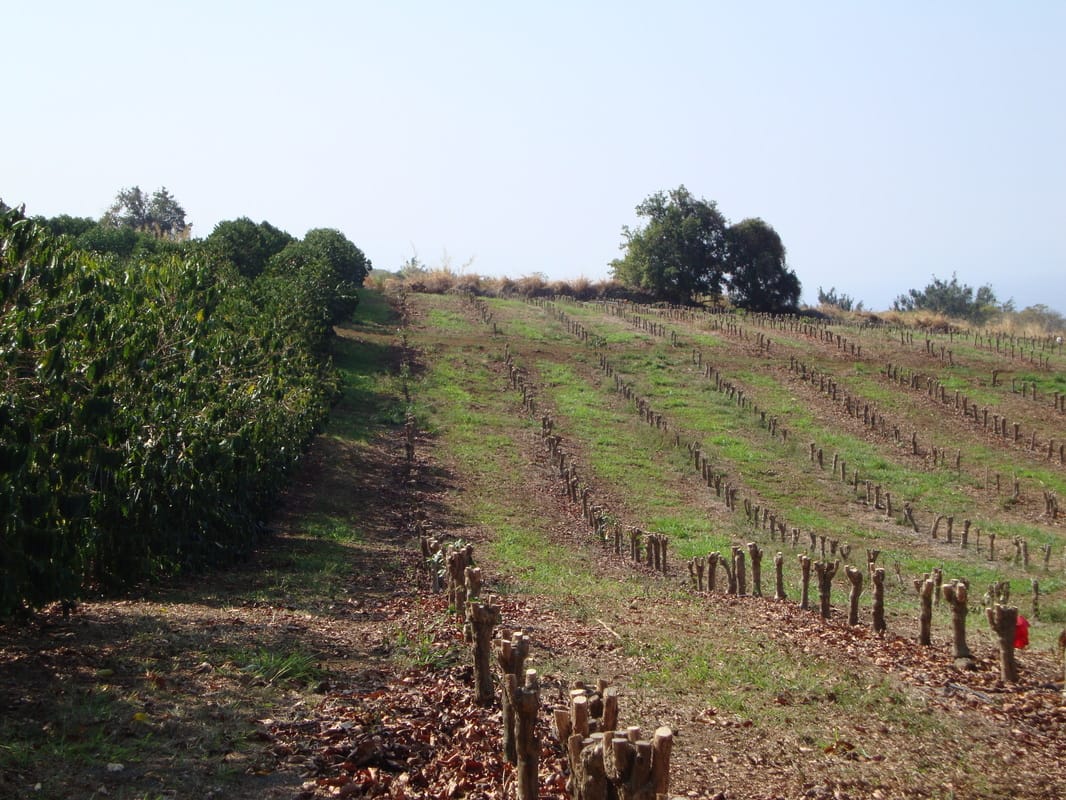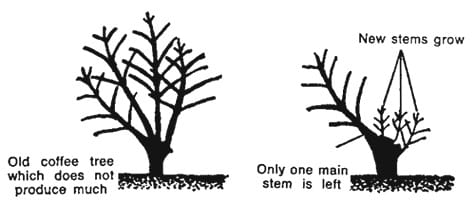Section IB: Pruning
The information below, is an excerpt from the "Recommendations for Coffee Berry Borer Integrated Pest Management in Hawai‘i 2020" document. The complete article can be downloaded here.
CBB management starts with several strip-picking rounds, including after harvest and before pruning. Strip-pick ALL (green, ripe, over-ripe, and raisin) coffee PRIOR to pruning to remove berries that otherwise would be dislodged and left in the field during the pruning process.
Stump-pruning by block is currently the only pruning method for establishing a large area without food or shelter for CBB. This pruning method can help to make other activities easier or more effective (e.g., harvesting more easily, achieving better spray coverage and penetra-tion into the interior of the tree, etc.)
If not actively farming coffee, consider stump-pruning your coffee trees when neighbors are pruning their trees to help neighboring farms in their attempts to control CBB.
Stump-pruning by block is currently the only pruning method for establishing a large area without food or shelter for CBB. This pruning method can help to make other activities easier or more effective (e.g., harvesting more easily, achieving better spray coverage and penetra-tion into the interior of the tree, etc.)
- Stump-prune trees AFTER strip-picking all green, ripe, over-ripe, and raisin coffee. Stump- pruning in blocks may control CBB infestations within an orchard during the first year of production.
- Stump pruning by rows, i.e., Beaumont-Fukunaga style of pruning, will not control CBB.
- Avoid stump-pruning during drought. Trees need rainfall or irrigation and proper nutrition to recover.
- If you must stump-prune during a drought, retain a “nurse vertical” to reduce tree shock and losses from stumping. The nurse vertical can be removed after new shoots emerge, and new shoots should be thinned to 3 or 4 main verticals [2].
If not actively farming coffee, consider stump-pruning your coffee trees when neighbors are pruning their trees to help neighboring farms in their attempts to control CBB.
|
Block-stumping
This is an example of field that was stump pruned following the end of harvest and after strip-picking. No berries developed until the following season, leaving about one year for CBB to find other homes and to emigrate from this field. Traps can be set up in the field to capture and kill residual beetles.
One of the smallest known stumped blocks is an area with about 250 trees. |
Depiction of a nurse vertical
|
Remember that strip-picking, the removal of ALL berries and raisins from the tree, must be done BEFORE pruning.
Additional publications and information related to coffee pruning:
- Coffee Cultural Practices in the Kona District of Hawaii
- Growing Coffee in Hawaii - pruning information starts on page 26
- Economic Evaluation of Mechanized Pruning of Coffee in Hawaii
- Pruning section of the 2016 CBB IPM Recommendations document
- General coffee presentation with pruning, pests, etc. by Skip Bittenbender
- Factors Affecting the Growth and Yield of Coffee in Kona, Hawaii - Coffee pruning Extension publication by Beaumont and Fukunaga
- Banana Moth as a Pest of Coffee
- Additional information and photos of Banana Moth - Extension publication by Zarders et al.
- Black Twig Borer informational webpage
- Coffee root-knot nematode informational webpage
- How to sample for coffee root-knot nematode
- How to take coffee leaf and soil samples
Poster presentation at the Hawaii Coffee Association's Annual Conference
2019 Pruning Techniques to Increase Profitability of Coffee Farms: 2019 Update
2019 Pruning Techniques to Increase Profitability of Coffee Farms: 2019 Update
Further reading:
[2] Beaumont, J.H., and E.T. Fukunaga. 1958. Factors affecting the growth and yield of coffee in Kona, Hawaii. Hawaii Agricultural Experiment Station Bulletin 113. http://www.ctahr.hawaii.edu/oc/freepubs/pdf/B-113.pdf.
[2] Beaumont, J.H., and E.T. Fukunaga. 1958. Factors affecting the growth and yield of coffee in Kona, Hawaii. Hawaii Agricultural Experiment Station Bulletin 113. http://www.ctahr.hawaii.edu/oc/freepubs/pdf/B-113.pdf.
Contact website management if you require any assistance with the site or information provided.

